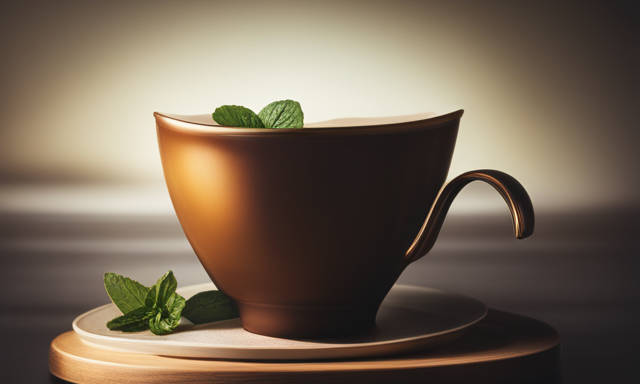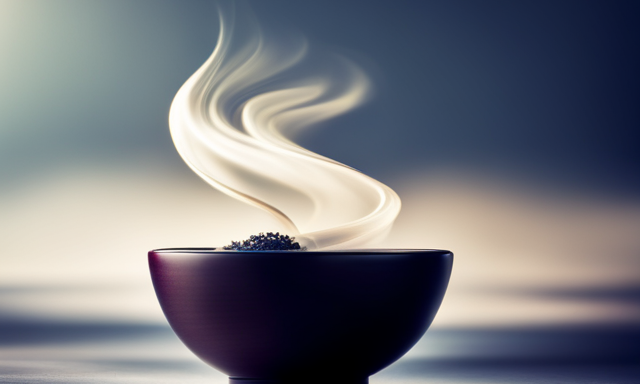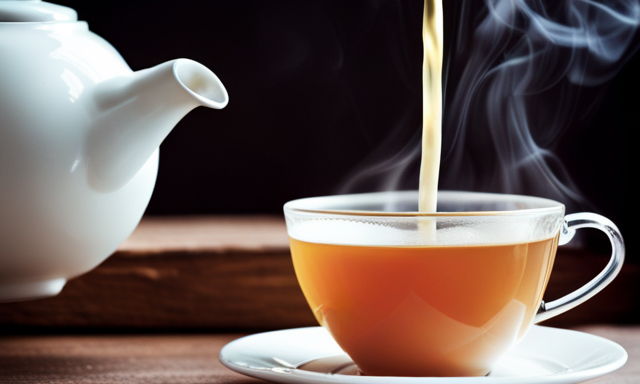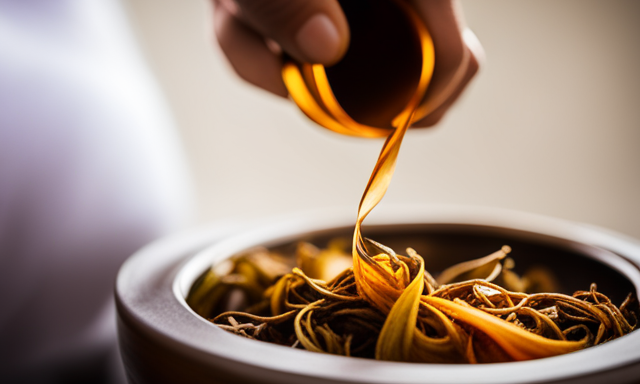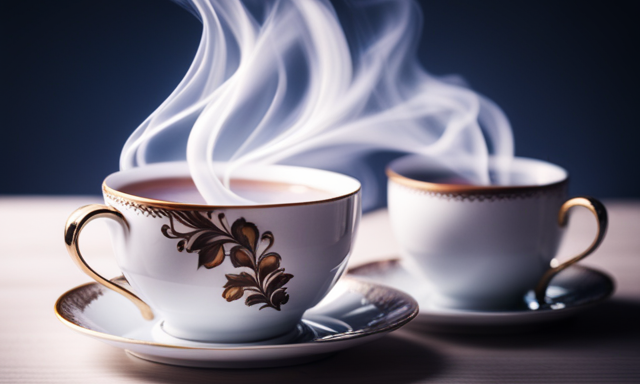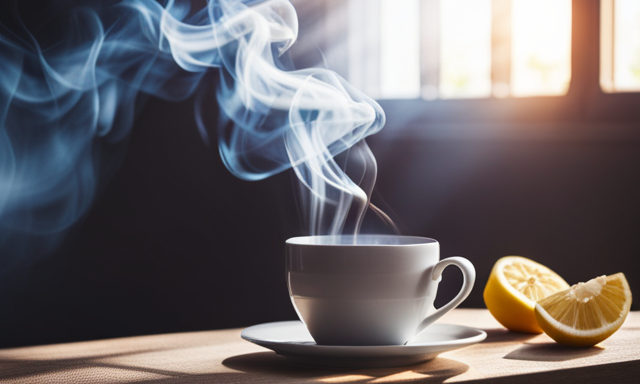I know what you’re thinking. ‘Oolong tea is delicious on its own, why would I want to put anything in it?’ Trust me, I had the same doubts. But once I started experimenting with different additions, I discovered a whole new world of flavors and aromas that took my oolong tea experience to the next level.
In this article, I’ll share with you some classic and unconventional ingredients that you can add to your oolong tea to enhance its taste and create your own signature blend. From the traditional milk and sugar to citrus zest, herbal infusions, spices, fruits, honey, nuts, and even floral notes, the possibilities are endless.
Whether you prefer a creamy and sweet cup or a refreshing and zesty one, there’s something for everyone. So, grab your favorite oolong tea and let’s explore the exciting world of oolong tea additions together.
Key Takeaways
- Pair oolong tea with tropical fruits for a refreshing twist
- Enhance the flavor of oolong tea with warming spices like cinnamon, cardamom, or ginger
- Experiment with herbs such as mint, lemongrass, or basil for unique and aromatic infusions
- Embrace the versatility of oolong tea and explore endless flavor combinations
Classic Additions: Milk and Sugar
When it comes to oolong tea, adding a splash of milk and a hint of sugar can transform its flavors into a creamy and indulgent experience. While some may prefer to enjoy oolong tea on its own, exploring alternative sweeteners can add a unique twist. Honey, agave syrup, or even stevia can provide a natural sweetness that complements the rich and earthy notes of oolong tea.
Additionally, milk plays a crucial role in enhancing the flavor profile of oolong tea. The creamy texture of milk adds a velvety smoothness to the tea, balancing out any bitterness and bringing out its natural sweetness. Whether you prefer cow’s milk, almond milk, or soy milk, each will contribute its own distinct taste.
Now, let’s move on to exploring the vibrant and refreshing addition of citrus zest: lemon, orange, or lime.
Citrus Zest: Lemon, Orange, or Lime
Lemon, orange, or lime zest adds a burst of vibrant citrus flavor to your oolong tea, like a ray of sunshine on a cloudy day. When using citrus zest in other beverages, such as iced tea or cocktails, it enhances the refreshing and invigorating qualities. In cooking, citrus zest can elevate both sweet and savory recipes. Here are four ways to incorporate citrus zest into your oolong tea experience:
- Sprinkle a pinch of lemon zest on top of your brewed oolong tea for a bright and tangy twist.
- Add a hint of orange zest to your oolong tea while steeping to infuse it with a subtle citrus aroma and flavor.
- Squeeze a splash of fresh lime juice and sprinkle some lime zest into your oolong tea for a zesty and refreshing kick.
- Experiment with combinations by using a mix of lemon, orange, and lime zest to create a complex and layered citrus taste.
Now, let’s explore the next exciting topic: herbal infusions with mint, chamomile, or lavender.
Herbal Infusions: Mint, Chamomile, or Lavender
If you’re looking to add a touch of relaxation to your cup, consider infusing your herbal tea with mint, chamomile, or lavender for a calming and soothing experience. Herbal infusions have numerous benefits for relaxation, sleep, and digestion. Mint is known for its ability to aid digestion and relieve stress, while chamomile is renowned for its calming properties, promoting better sleep and reducing anxiety. Lavender, on the other hand, helps to relax the mind and body, easing tension and promoting a sense of well-being.
To choose the right herbal infusion for your needs, consider your desired effects. If you’re looking to unwind after a long day, chamomile or lavender may be the perfect choice. Mint, on the other hand, can help with digestion and provide a refreshing burst of flavor.
Now, let’s move on to the next section about spices: cinnamon, ginger, or cardamom, for an added kick to your oolong tea.
Spices: Cinnamon, Ginger, or Cardamom
Enhance your herbal infusion with a touch of warmth and spice by adding cinnamon, ginger, or cardamom for a truly invigorating experience.
When it comes to pairing spices with oolong tea, both cinnamon and ginger offer unique flavor profiles. Cinnamon brings a sweet and slightly spicy taste, while ginger adds a warm and zesty kick. Experimenting with these spices allows you to discover your preferred combination.
Additionally, cardamom infused oolong tea offers a unique twist on a classic pairing. The aromatic and slightly citrusy notes of cardamom beautifully complement the earthy tones of oolong tea, creating a harmonious blend.
Next, we’ll explore how fruits like peach, mango, or strawberry can elevate your oolong tea.
Fruits: Peach, Mango, or Strawberry
Indulge yourself in the juicy sweetness of ripe peaches, succulent mangoes, or luscious strawberries as they infuse your senses with a burst of vibrant flavors and transport you to a sun-kissed orchard in the midst of summer.
When it comes to pairing fruits with oolong tea, the debate between peach and mango is tough. Both fruits bring their own unique qualities to the table. The rich, velvety taste of mango complements the smoothness of oolong tea, creating a harmonious blend of tropical notes. On the other hand, the delicate sweetness of peaches adds a refreshing twist to the earthy undertones of oolong tea.
As for strawberries, their natural sweetness dances playfully with the robust flavors of oolong tea, resulting in a match made in heaven.
Now, let’s delve into the next topic and explore the enchanting world of honey or agave syrup.
Honey or Agave Syrup
When deciding between honey and agave syrup, one must consider the distinct flavors they bring to a dish. Honey, a natural sweetener, adds a rich and floral taste to oolong tea. It also offers numerous health benefits such as antioxidant properties and soothing effects on the throat.
On the other hand, agave syrup provides a mild and neutral sweetness without overpowering the delicate flavor of the tea. It’s a popular alternative for those who prefer a vegan or low-glycemic option. Both honey and agave syrup can enhance the overall taste of oolong tea, so the choice ultimately depends on personal preference.
Moving on to the next section, let’s explore the options of nuts: almonds, walnuts, or pecans, to further enhance the flavor profile of oolong tea.
Nuts: Almonds, Walnuts, or Pecans
If you’re looking to add a delightful crunch and a burst of flavor to your favorite brew, consider the options of almonds, walnuts, or pecans. Nuts can be a great addition to oolong tea, but it’s important to keep in mind any nut allergies you or your guests may have.
Almonds are a popular choice, known for their rich and buttery flavor. Walnuts offer a slightly bitter taste that complements the earthy notes of oolong tea. Pecans, on the other hand, bring a sweet and nutty flavor to the mix. Each nut also comes with its own set of health benefits, such as almonds being high in vitamin E and walnuts being a good source of omega-3 fatty acids.
When considering what to put in your oolong tea, keep these options in mind for a tasty and nutritious addition. Now, let’s move on to the next section and explore the floral notes of rose, jasmine, or elderflower.
Floral Notes: Rose, Jasmine, or Elderflower
In my previous exploration of oolong tea, I delved into the delightful addition of nuts like almonds, walnuts, or pecans. Now, let’s venture into the realm of floral notes and their enchanting blend with oolong tea.
Pairing floral notes with different tea types can create a truly captivating experience for your taste buds. When it comes to oolong tea, some popular choices include rose, jasmine, or elderflower. Not only do these floral infusions add a delightful aroma to the tea, but they also bring forth their own set of health benefits.
Rose tea, for example, is known for its calming properties, while jasmine tea is believed to aid in digestion. Elderflower, on the other hand, is known for its immune-boosting qualities.
Now, let’s transition into the subsequent section, where we will experiment with unique combinations and discover the true potential of oolong tea.
Experiment with Unique Combinations
Explore the realm of unique combinations and unlock a world of flavor possibilities with oolong tea. Experimenting with unusual flavor combinations can take your oolong tea experience to new heights. Not only does it tickle your taste buds, but it also offers a chance to explore the health benefits of oolong tea.
Here are three sub-lists to inspire your creativity:
-
Fruity Infusions: Pair oolong tea with tropical fruits like pineapple or passion fruit for a refreshing twist. The fruity notes complement the natural sweetness of oolong tea, creating a harmonious blend.
-
Spiced Delights: Incorporate warming spices like cinnamon, cardamom, or ginger into your oolong tea for a cozy and comforting drink. These spices not only enhance the flavor but also offer potential health benefits.
-
Herbal Infusions: Experiment with herbs like mint, lemongrass, or basil to add a refreshing and aromatic touch to your oolong tea. These herbs can provide additional health benefits and create a unique flavor profile.
With oolong tea as your canvas, the possibilities are endless. Get creative and indulge in the delightful exploration of unique flavor combinations.
Frequently Asked Questions
Can I add honey or agave syrup to my oolong tea?
Yes, you can definitely add honey or agave syrup to your oolong tea. Honey adds a natural sweetness and has potential health benefits, while agave syrup provides a smooth taste. Additionally, you can experiment with different types of milk or cream to add a creamy touch to your oolong tea.
What are some unique combinations to experiment with when it comes to oolong tea?
Oh, the possibilities are endless when it comes to experimenting with oolong tea! From making a refreshing iced version to pairing it with different types of desserts, oolong tea truly knows how to satisfy your taste buds.
Is it common to add nuts like almonds, walnuts, or pecans to oolong tea?
Adding nuts like almonds, walnuts, or pecans to oolong tea is not very common. However, it can bring health benefits and unique flavor profiles. Some popular nut-infused oolong tea recipes include almond oolong and walnut oolong.
Are there any specific herbal infusions that go well with oolong tea, such as mint, chamomile, or lavender?
Rosemary and lemongrass are excellent herbal infusions to pair with oolong tea. Their unique flavors complement oolong’s earthy notes and create a harmonious blend. Try adding a sprig of rosemary or a few lemongrass stalks to enhance your oolong experience.
Can I enhance the flavor of oolong tea by adding citrus zest like lemon, orange, or lime?
Adding citrus zest like lemon, orange, or lime to oolong tea can enhance its flavor. In fact, a study found that the aroma of citrus can improve the taste perception of tea. Consider trying alternative sweeteners like honey or stevia for a unique twist.
Conclusion
In conclusion, there are so many delicious options to add to your oolong tea. From classic choices like milk and sugar to more adventurous combinations like citrus zest and spices, the possibilities are endless. So why settle for plain tea when you can elevate your experience with a burst of flavor?
Whether you prefer a refreshing hint of mint or the sweet aroma of rose, there’s a perfect addition waiting to be discovered. So go ahead, get creative, and indulge in the delightful world of oolong tea. Isn’t it time to tantalize your taste buds?

